NVIDIA GeForce GTX 770 Review: The $400 Fight
by Ryan Smith on May 30, 2013 9:00 AM ESTAlthough GTX 770 is already a very high clocked part for GK104, we still wanted to put it through its paces when it comes to overclocking. Of particular interest here is actually memory overclocking, as this is the first video card shipping with 7GHz GDDR5 standard. This will let us poke at things to see just how far both the RAM itself and NVIDIA’s memory controller can go.
Meanwhile the switch to GPU Boost 2.0 for GTX 770 is going to change the overclocking process somewhat compared to GTX 680 and GTX 670. Overvolting introduces marginally higher voltages and boost bins to play with, while on the other hand the removal of power targets in favor of TDP means that we only get 106% – an extra 14W – to play with in TDP limited scenarios. Thankfully as we’ve seen we’re generally not TDP limited on GTX 770 at stock, which means our effective headroom should be greater than that.
| GeForce GTX 770 Overclocking | ||||
| Stock | Overclocked | |||
| Core Clock | 1046MHz | 1146MHz | ||
| Boost Clock | 1085MHz | 1185MHz | ||
| Max Boost Clock | 1136MHz | 1241MHz | ||
| Memory Clock | 7GHz | 8GHz | ||
| Max Voltage | 1.2 | 1.212v | ||
We’re actually a bit surprised we were able to get another 100MHz out of the GPU itself. Even without the extra overvoltage boost bin, we’re still pushing 1200MHz+ on 1.2v, which is doing rather well for GK104. Of course this is only a 9% increase in the GPU clockspeed, which is going to pale in comparison to parts like GTX 670 and GTX 780, each of which can do 20%+ due to their lower clockspeeds. So there’s some overclocking headroom in GTX 770, but as to be expected it's not a lot.
More interesting however is the memory overclock. We’ve been able to put another 1GHz on 6GHz GTX 680 cards in the past, and with the 7GHz base GTX 770 we’ve been able to pull off a similar overclock, pushing our GTX 770 to an 8GHz memory clock. The fact that NVIDIA’s memory controller can pull this off is nothing short of impressive; we had expected there to be some headroom, but another 14% is beyond our expectations. At this clockspeed the GTX 770 has a full 256GB/sec of memory bandwidth, 33% more than both a stock GTX 680 and the 384-bit GTX 580. Of course we’ll see if GTX 770 can put that bandwidth to good use.
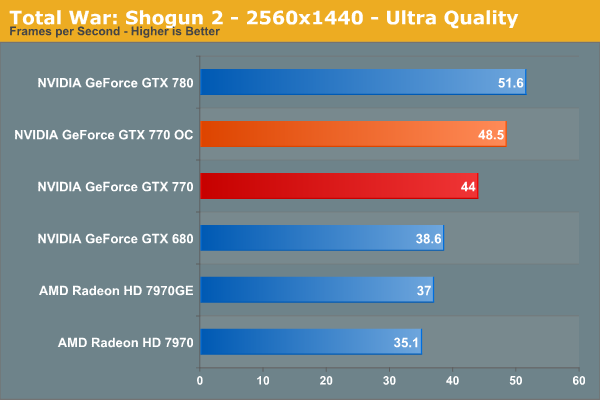
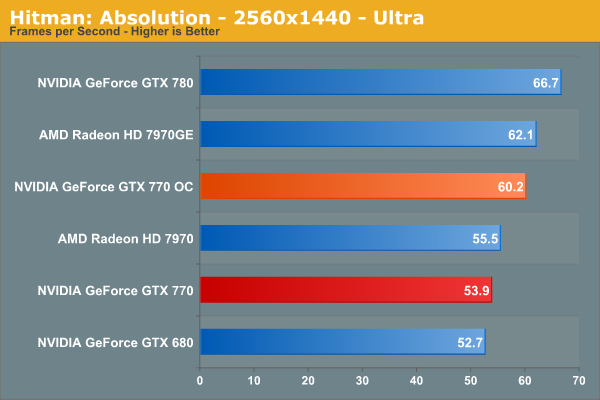
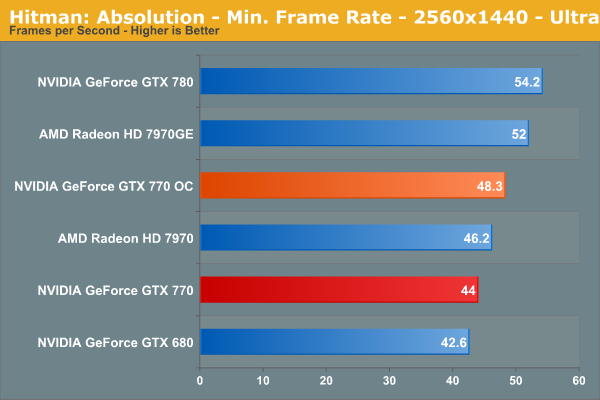
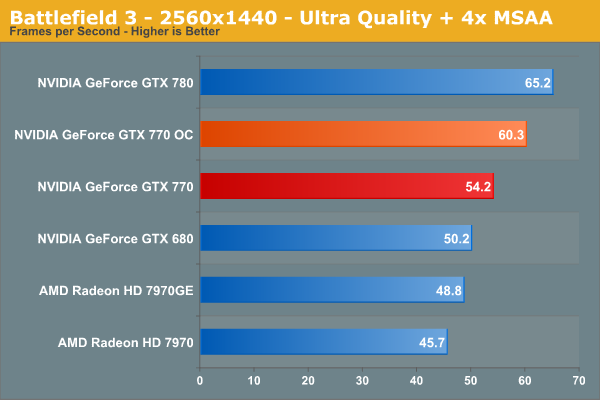
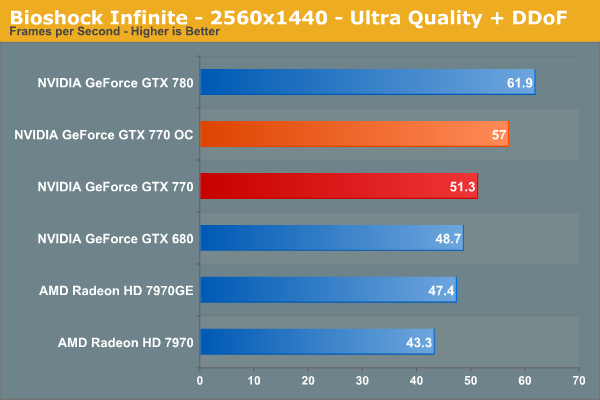
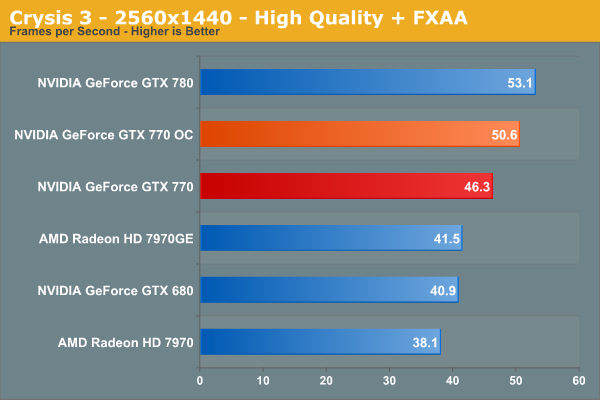
The end result of our overclocking efforts nets a very consistent 9%-12% increase in performance across our games. 9% is the upper bound for improvements due to GPU overclocking, so anything past that means we’re also benefitting from the extra memory bandwidth. We aren’t picking up a ton of performance from memory bandwidth as far as we can tell, but it does pay off and is worth pursuing, even with the GTX 770’s base memory clock of 7GHz.
Overall overclocking can help close the gap between the GTX 770 and 7970GE in some games, and extend it in others. But 10% won’t completely close the gap on the GTX 780; at best it can halve it. GTX 780’s stock performance is simply not attainable without the much more powerful GK110 GPU.
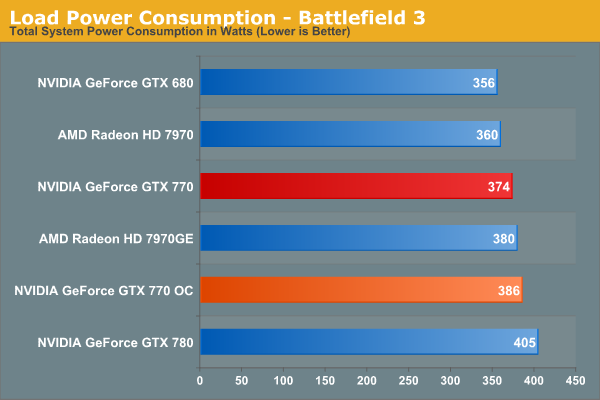
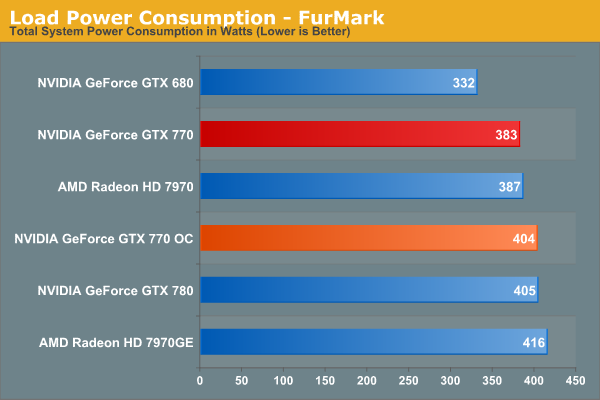
Moving on to power consumption, we can see that the 106% TDP limit keeps power usage from jumping up by too much. In Battlefield 3 this is a further 12W at the wall, and 21W at the wall with FurMark. In games this means our power usage at the wall is still below GTX 780, though we’ve equaled it under FurMark.
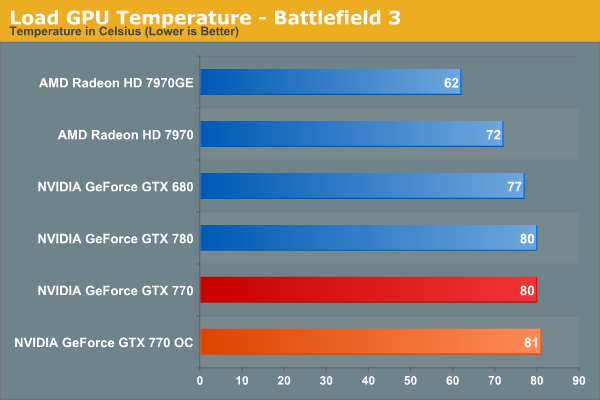
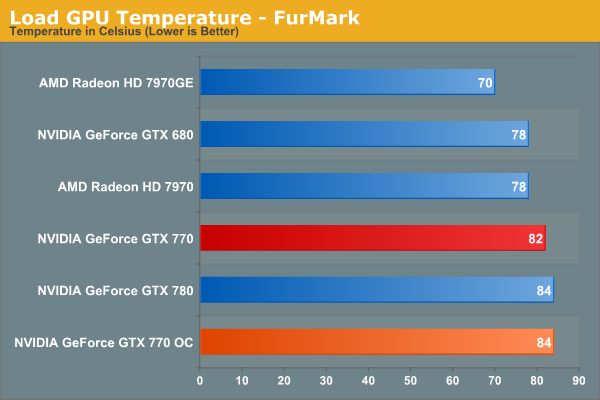
The fan curve for GTX 770 appears to be identical to that of GTX 780. Which is to say the fan significantly ramps up around 84C, keeping temperatures in the low-to-mid 80s even though GPU Boost 2.0 is allowed to go up to 95C.


Finally for fan noise, we see a small increase under Battlefield 3, and no change under FurMark. 1.5dB louder under Battlefield 3 puts noise levels on par with the GTX 780, sacrificing some of GTX 770’s abnormally quiet acoustics, but still keeping noise below the 50dB level. Or to put this another way, the performance gains for overclocking aren’t particularly high, but then again neither is the cost of overclocking in terms of noise.










117 Comments
View All Comments
Catalina588 - Thursday, May 30, 2013 - link
Folding@Home Big-Time Discrepancy in reviewsCan anyone explain the material differences between this review's Compute Results for Folding@Home and the same FAHbench run at Tom's Hardware?
http://www.tomshardware.com/reviews/geforce-gtx-77...
Since FAHbench is self-contained -- load and go -- it's hard to figure how the results could be so different.
Ryan Smith - Thursday, May 30, 2013 - link
We're using a newer version of the benchmark, 1.2. FAHBench 1.2 has some very big performance optimizations that aren't in 1.1x.kyuu - Thursday, May 30, 2013 - link
Not bad, but I think I'd still just find a 7970 with a good cooler on sale and overclock the crap out of it if I was looking to buy a high-end GPU.Lt_dan - Thursday, May 30, 2013 - link
People should be looking at other websites. This review is showing scores that don't even make sense. The 7970, on bf3, has the same score as tomshardware's review of the 680, which was done over the year ago.azixtgo - Thursday, May 30, 2013 - link
nobody cares. If this were ~$300 I'd seriously consider it. But getting a 7950 for ~$300 along with 4 quality games just makes me not care about a $400 card thats already out of my budget anyway. Nvidia always keeps their best just too high. At 400 its competing in value against a card with more to offer. They don't have the concept of winning by pricing right, but I guess they've never had to go there like AMD did.Razorbak86 - Thursday, May 30, 2013 - link
Just because YOU don't care, doesn't mean that NOBODY cares. Please don't attempt to speak for the rest of us.agentwax - Thursday, May 30, 2013 - link
Hmm recently built a system with gigabyte 670 and was looking to go sli in the near future. Upon reading this review I'm second guessing. Should I get a second 670 in a few months and go sli Or a 770 and go sli some time around christmas? Very happy with temps and noise on gigabyte wind force 670thunderising - Friday, May 31, 2013 - link
Now it's time for a HD 7970 GHZ GHZ MEGA GHZ edition with faster clocks and a new driver release for improved performance. HeheheAt least that would be better than a HD8950 = HD 7970 with faster clock speeds.
evolucion8 - Friday, May 31, 2013 - link
That is not correct. The HD 7970 has a bigger bus, but being 28nm instead of 40nm like the HD 6970 means that the HD 7970 was able to achieve great performance gains by being 354mm2 compared to the HD 6970 which is around 389mm2colonelclaw - Friday, May 31, 2013 - link
Is anyone else as disappointed as I am about pricing all the way across the board with this new generation? As an owner of a GTX580 I was thinking it's about time for an upgrade, but all these high end cards look 100 $/£/€ overpriced to me. I wasn't happy about paying £450 for my 580 but there's no way in hell I'm prepared to pay £550 for the 780, and the 770 isn't a big enough upgrade to interest me.I'm more than a little suspicious that AMD and NVidia are agreeing on price points in order to make larger profits. Having just 2 companies in a market sector makes it pretty easy for them to do this.